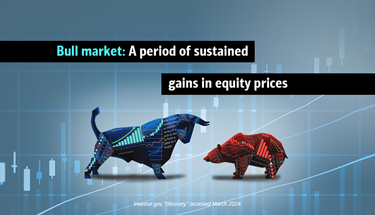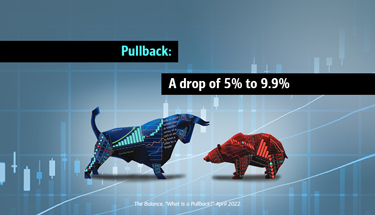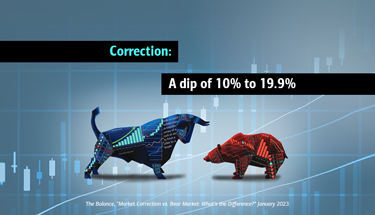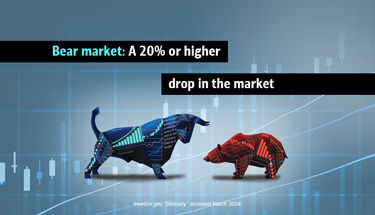7 tips for dealing with a prolonged market downturn
Here’s what you may want to do — and avoid doing — as you maneuver through an extended decline
It’s totally normal to get a little worried when you see the value of your investments drop. You might be thinking, “Is this what a bear market looks like? And what should I do now?”
“Selling when the market is down means you might miss the recovery”
“A bear market is when major U.S. stock indices, like the S&P 500, drop by 20% or more from their peak,” explains Marci McGregor, head of Portfolio Strategy for the Chief Investment Office (CIO), Merrill and Bank of America Private Bank. “There have been more than 21 bear markets in the S&P 500 since 1928,1 and they usually last less than a year, compared to the multiyear span of a typical bull market,” she adds.
Down markets can be unsettling, but there are ways to keep things in perspective and maybe even benefit from the situation. Here are seven tips from McGregor and other experts from the CIO to help you get through a prolonged market downturn.





1. Don’t react impulsively. When the market takes a dive, it’s tempting to pull out your money until things look better. But that can lead to costly mistakes, partly because it’s never obvious when to get back in the market. Selling when the market is down means you might lock in a permanent loss and miss the recovery. The key is to stay in the market for the long haul, not to try and time it.
TIP: Be patient, tune out the daily ups and downs of the market and stay focused on your long-term goals.
2. Ask yourself: How quickly might I need to draw down my assets. In a bull market, it’s easy to forget how tough it can be when your assets lose value. If you’re nearing retirement, it might be smart to sit down with your advisor and look at your risk. “Investors with longer time horizons can usually handle market volatility. But if you need to access your investments soon, consider a more conservative approach,” says McGregor.
TIP: Consider moving assets that you may need to draw upon in the next year into Treasurys or money market funds
3. Diversify your portfolio. “One way to limit the impact of a market downturn is to diversify a U.S. stock portfolio with other kinds of investments, including international stocks; longer-term, high-quality bonds like treasurys and high-grade corporate and municipal bonds; and other assets,” says Matthew Diczok, head of Fixed Income Strategy, Chief Investment Office, Merrill and Bank of America Private Bank. By mixing in bonds and cash with your stocks, you might be able to smooth out some of the market’s ups and downs, potentially losing less in the downturns.
TIP: Look for ways to increase your portfolio’s diversification within as well as across asset classes.
4. Keep investing regularly. By putting a fixed amount of money into your investments at regular intervals, you’re more likely to buy stocks at lower prices and potentially see them rise in value when the market recovers. This strategy, called dollar cost averaging, can be efficient when the market is down.
TIP: Automate regular contributions into your investment accounts and consider reinvesting your dividends.
5. Look for strategic opportunities. In a downturn, defensive stocks like consumer staples, healthcare and utilities, as well as companies with strong balance sheets, can offer opportunities. Higher-quality stocks that pay dividends, especially shares of companies that have consistently grown their dividends, might help boost your total return when stock prices are falling.
TIP: Look for buying opportunities that volatility might create – for instance, among stocks that might have been overvalued before.
6. Rebalance your portfolio. During a long bull market, your stocks might grow faster than your bonds or cash, throwing your portfolio out of balance. Use this time to fix any imbalances. If your portfolio has strayed from your strategic plan, consider moving some assets to address the imbalance. For example, if your stock portfolio has grown beyond your target asset allocation, it may be time to rebalance a portion of it into bonds.
TIP: Doing this on a regular basis can help keep your portfolio aligned to your goals, timelines and risk tolerance.
7. Keep things in perspective. No matter how long or deep the downturn, markets have bounced back in the past. “Bear markets have happened in the past, and history shows that markets recover and grow higher than before,” says McGregor. “Investors who stay calm and disciplined during a negative market are likely to avoid common mistakes and potentially enjoy better times ahead. The longer you stay invested, the better your chances of meeting your long-term goals.”
TIP: Stay in touch with your advisor throughout any prolonged downturn. They can talk you through the risks and opportunities and suggest ways you can respond to help you stay on track as you pursue your goals. And as markets begin their recovery, they can help you take advantage of changing conditions.
Take advantage when markets are down
While no one likes to see their balances fall, reduced asset values offer unique financial planning opportunities. Consider these strategies:
Tax-loss harvesting. In addition to benefiting from dollar-cost averaging or rebalancing into cheaper parts of the market when security prices are low, you may also find opportunities to offset taxes on gains through losses generated by strategic sales of underperforming securities.
Roth IRA conversions. When asset values are down, it may be a good time to consider moving traditional IRA assets to a Roth IRA. Assets are taxed during conversion, so lower asset prices may mean a smaller tax bill.
Estate moves. It’s worth looking at your estate plan, as it may be beneficial to fund trusts and make certain gifts when asset prices are lower.
A private wealth advisor can help you get started.
1 Source: Yardeni Research Inc. data as of March 7, 2024.
Important Disclosures
Opinions are as of 10/02/2024 and are subject to change.
Investing involves risk, including the possible loss of principal. Past performance is no guarantee of future results.
Investments have varying degrees of risk. Some of the risks involved with equity securities include the possibility that the value of the stocks may fluctuate in response to events specific to the companies or markets, as well as economic, political or social events in the U.S. or abroad. Bonds are subject to interest rate, inflation and credit risks. Treasury bills are less volatile than longer-term fixed income securities and are guaranteed as to timely payment of principal and interest by the U.S. government. Investments in foreign securities (including ADRs) involve special risks, including foreign currency risk and the possibility of substantial volatility due to adverse political, economic or other developments. These risks are magnified for investments made in emerging markets. Investments in a certain industry or sector may pose additional risk due to lack of diversification and sector concentration.
Asset allocation, diversification, dollar cost averaging and rebalancing do not ensure a profit or protect against loss in declining markets.
The Chief Investment Office (CIO) provides thought leadership on wealth management, investment strategy and global markets; portfolio management solutions; due diligence; and solutions oversight and data analytics. CIO viewpoints are developed for Bank of America Private Bank, a division of Bank of America, N.A., (“Bank of America”) and Merrill Lynch, Pierce, Fenner & Smith Incorporated (“MLPF&S” or “Merrill”), a registered broker-dealer, registered investment adviser and a wholly owned subsidiary of Bank of America Corporation (“BofA Corp.”).
A program of regular investment cannot assure a profit or protect against a loss. A continuous or periodic investment plan involves investment in shares over time regardless of fluctuating price levels. You should consider your financial ability to continue purchasing shares during periods of low price levels.
Dividend payments are not guaranteed. The amount of a dividend payment, if any, can vary over time.
Explore more of our latest thinking
1 of 1


